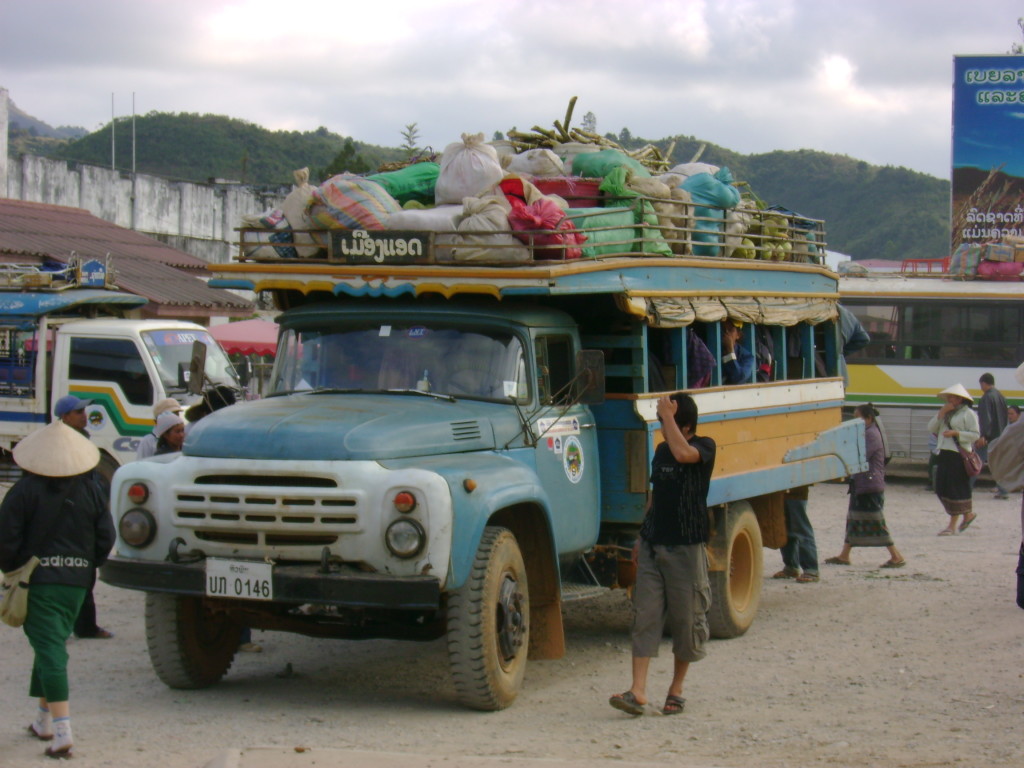Our Xam Tai Family
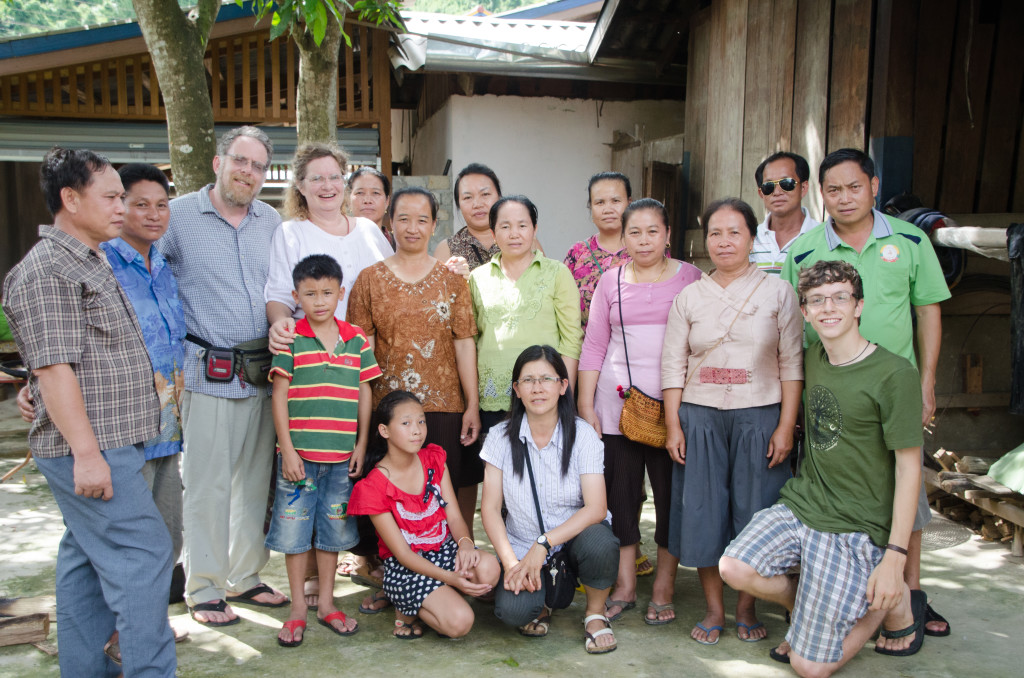
Our family has had the great fortune to become good friends and business partners with the world’s finest natural silk artists who live in the Xam Tai district in NE Laos.
In July, I caught myself doing something I thought I would never do. Maren and I were in the village of Xam Tai in Houaphon Province, NE Laos – our favorite re-visiting spot on all our ventures. The usual crew of weavers, dyers and local leaders – our friends – had trundled to a small restaurant on the banks of the Nam Xam (Xam River) where we could watch the sunset and have a drink to welcome the evening cool. Maren and I had just ordered another round of grilled duck meat and several bottles of BeerLao for anyone with an appetite and an empty glass. Of course the karaoke machine was on (no, the recent addition of electricity to Xam Tai did not improve every aspect of life). The vice governor of the region had just finished singing a Lao pop song – leading elders almost always seem to have the smoothest richest voices – when a cheer went up, and he handed the microphone to Maren and me.

Phout models one of her exquisite “man-woman” healing cloths. Phout is known for her rich purples and reds.
What to do? Neither one of us has a singing voice others really want to hear. I looked for help from, well anyone. “I don’t know any Lao songs,” I pleaded. Mai translated and everyone laughed. “Wait!” Mai announced in English. “We have American songs too.” Oh, no. The first was a Phil Collins song I had never heard. Perhaps Maren and I had escaped – but no. “We have one other,” Mai laughed. Yep – and for anyone who has traveled through the weird corners of the planet, the second song option will be an “of course.” A song so well-known we knew we could no longer avoid the inevitable. The lyrics play across the bottom of the console and Maren and I charge into the song that is a good half register too high for our voices:
On a dark desert highway, cool wind in my hair,
Warm smell of colitas, rising up through the air…
What is it about The Eagles anyway… and “Hotel California” is what – 40 years old?
We finally and thankfully finish – the locals, some with unevenly-raised eyebrows, cheer as they would cheer any performer. The microphone is passed to another and we return to Lao pop music.
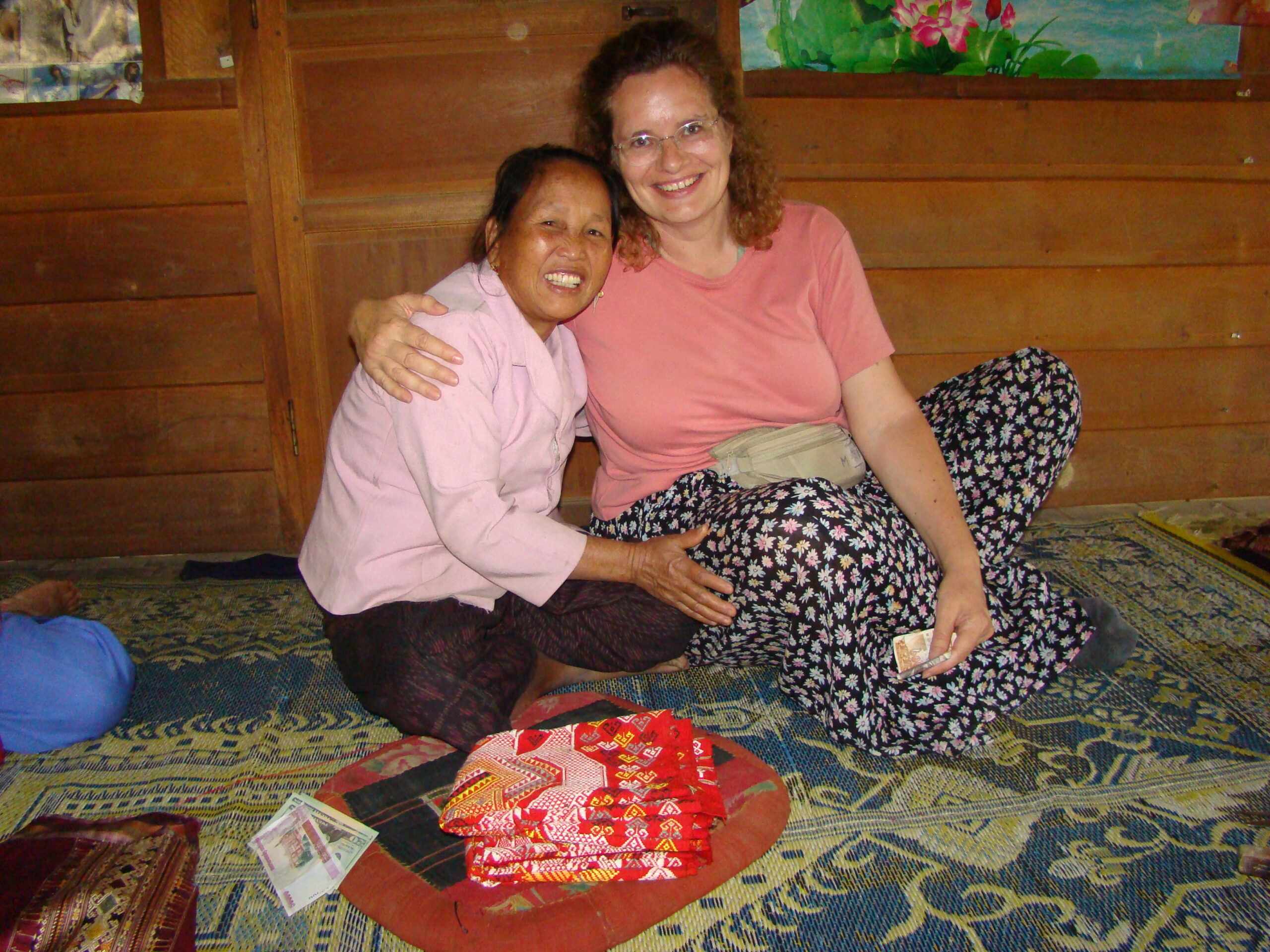
Sukavit and Maren in 2007. Sukavit, a village elder and “most-determined social-leader,” took it upon herself to full-heartedly welcome us into the community, which opened up so many doors for us. She and Maren are truly “two peas in a pod.”
Our family of four – mom, dad, and then 13-year-old Ari and 10-year-old Zall – first visited this region of Laos in 2006. A blurb in the Lonely Planet Guidebook briefly mentioned the quality silk artistry that local minority groups were famous for. But on our first visit we were backpack tourists, and only a dim spark of the fantasy of an import textile business had been lit.
Our memories of whom we met on that first 3-day visit are vague – who thought we would ever return? Xam Tai itself had only an hour a day of electricity and a single mildew-y $4/night guesthouse. Westerners were rare as the town is at an endpoint of a narrow sealed road. Only a rutted track continued into the jungle hills.
Now, after a “dozen plus” visits, Xam Tai feels like home. Sukavit, a 60’ish village elder and the first to invite us to join the village socially, now carries a few more lines on her face. She has recently handed the “reins of power” to her niece, Phout, who is a master-dyer and weaver, and also a very sharp business-woman. Phout, well-known for her deep purple and maroon-toned silks, carries waves of wonderful ebullient energy and a raucous sense of humor; she and Maren have formed a deep friendship over the years. And the party always begins when Phout arrives!
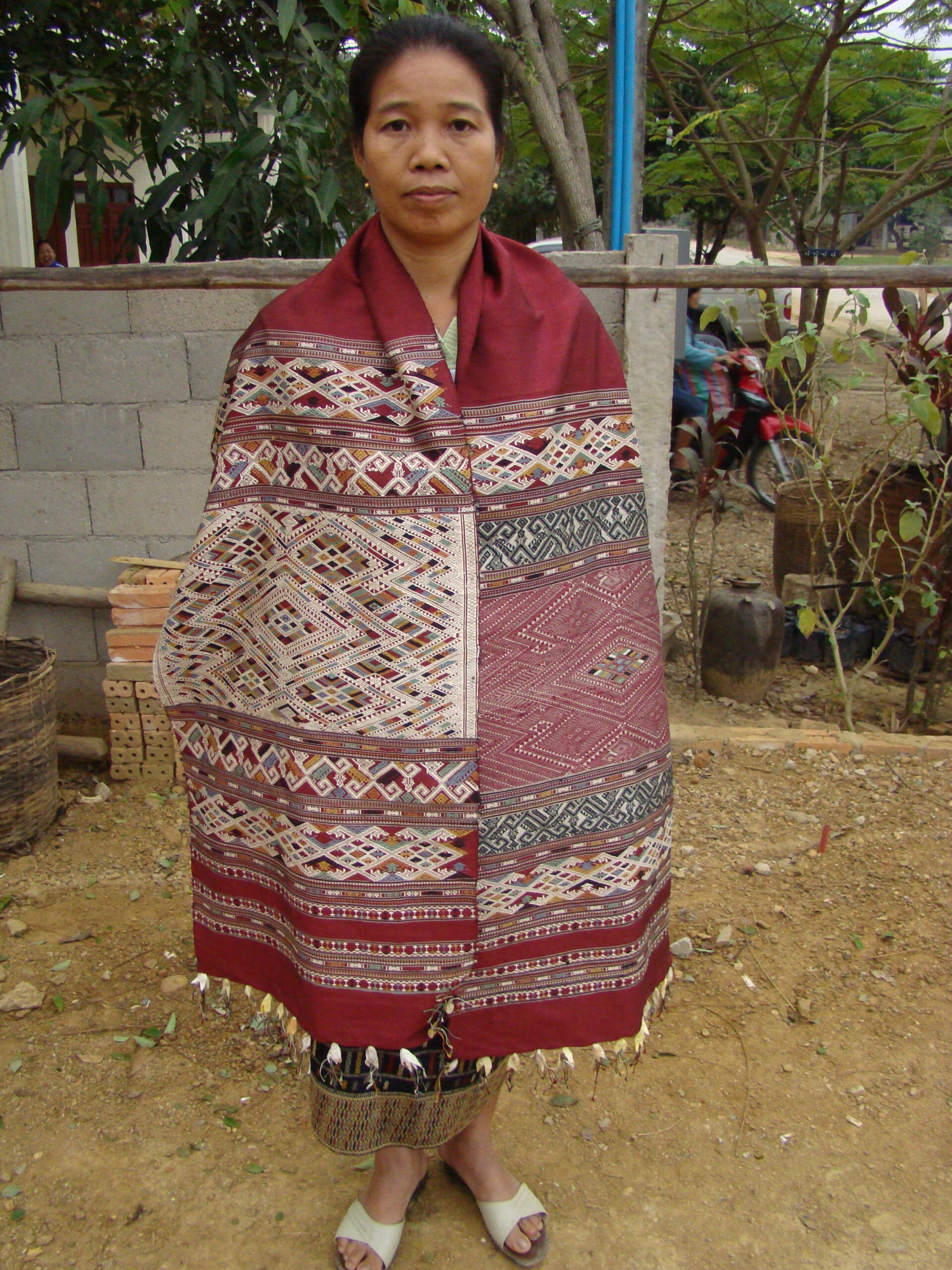
Souk’s masterpieces consistently represent the finest dyeing and weaving in the region. Souk continues to develop new natural dyes and woven art using traditional methods, materials and motifs.
Souksakone, the acknowledged best dyer in the Xam Tai region and who has presented to us what we believe to be the world’s finest and most intricate naturally-dyed silks, now opens up her home to us when we arrive and we share all meals. Three years ago Souk and her husband built their own small guesthouse (some of the funding for this came from our customers!), complete with air conditioning. Yes, here in 2014 Xam Tai now has 24/7 electricity, bringing with it a world of refrigerators, washing machines and florescent bulbs (allowing for weaving after dark). Sousakone and Phout have been best friends since childhood, although we do sense a prideful and serious competition.
Phout and Sukavit also grew up with Mai, who was one of the very few locals to be able to achieve a secondary, and then college education. Mai, who once taught college-level English in Laos’ capital city, is now the Director of Tourism Development for Houaphon Province. We met Mai in 2008 when she was able to offer us her translating skills on our third visit to Xam Tai – she herself got to return to her home village that she had not visited in many years and was enthusiastically greeted by, well… everyone. It was Mai who introduced us socially to Phout and Souk as her very good friends. [Sukavit, on the other hand, has no problems ever introducing herself to a visitor.] And for whatever reason, Phout, Souk, Mai and Maren have formed a tight and real bond – like 4 sisters. So much laughter, and sharing, and good meals, and smiles, and some business…
Now Mai (and her 11-year-old son Bingo) visit Xam Tai at least once a year – when we visit (and hire her translating services). Perhaps because we bring both cash and Mai back to Xam Tai regularly that the entire village has adopted us. We owe much to Mai for bridging the communication gap that hinders most cross-cultural relationships; her seamless translating makes an entire roomful of weavers and dyers and husbands and kids feel like family.
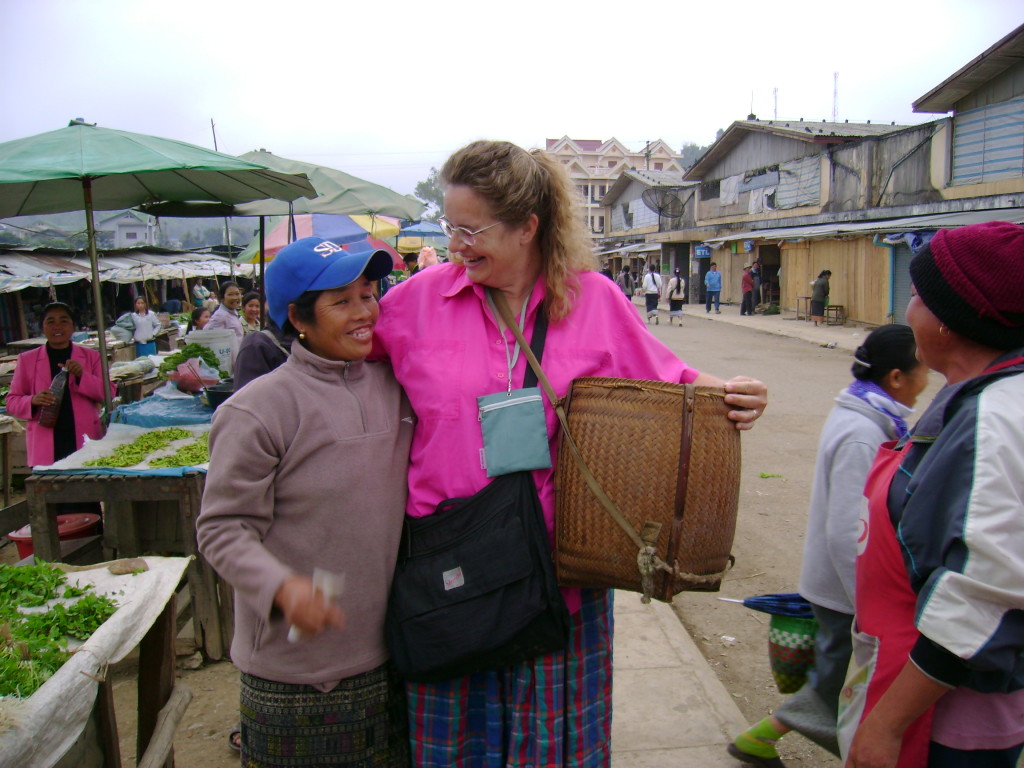
Maren in Xam Neua on our first “buying-visit” (and second formal visit) in 2007. Maren literally bought the basket off this woman’s back!
A quick word on friendship in Houaphon – it is a deeply felt and enduring commitment. Initially several of our Xam Tai friends hesitated to reciprocate our social efforts –westerners are known to come, and then go. It was about the fifth visit, all with our kids in tow (and once, even Josh’s 80 year-old mom), that people started to believe we could be counted on to keep the bonds of friendship vital. But once you proclaim a true friendship – once you look into someone’s eyes and tell them you like them and want to share – that friendship becomes deep and real, and it comes with obligations of trust. It is a commitment, and that recognition allows for a meaningful connection with someone who seems so different on the surface, but is so close at heart. There is comfort, clarity and contentment with a trusted friend. It is perhaps the greatest gift that humans can share. It runs all we truly hold dear.
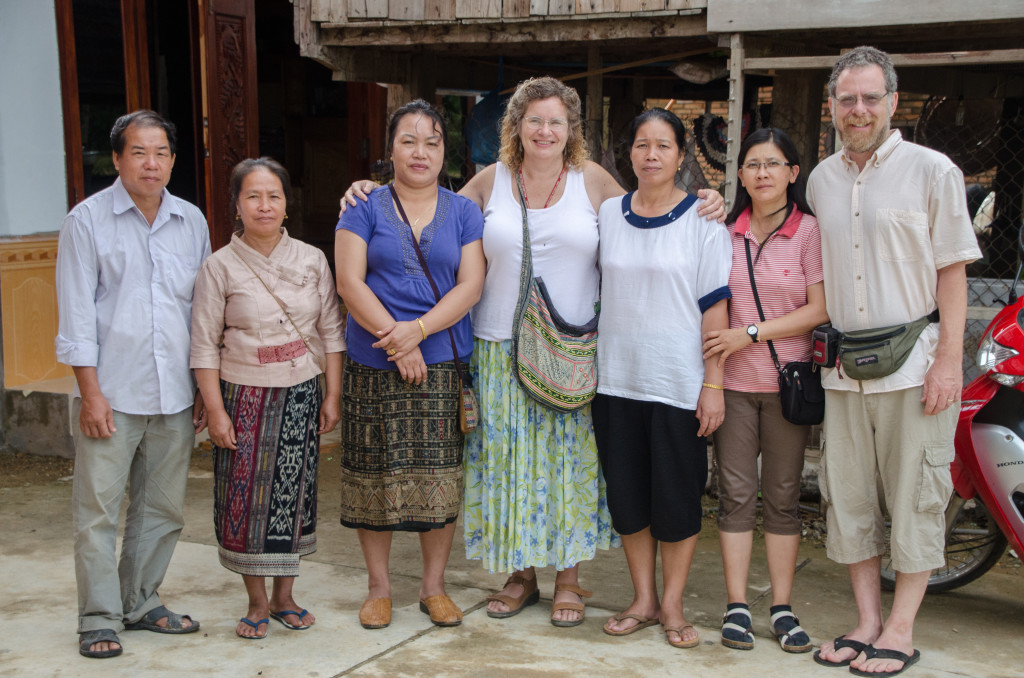
Good friends: Bonkeo (Lun’s husband), Lun, Phout, Maren, Souk, Mai and Josh. Lun, Phout and Souk are the region’s leading dye-and weaving experts and business-persons. Mai, childhood friends of these artists, is able to translate so very well!
Other wonderful artists and village characters have been introduced to us over the years: Lun (another most talented master-dyer), the Vilays (who always have a couple unusual textiles), the vice governor of the district and his extended family, the elders in the near-by silk-raising village of Ban, sweet Chola (whom we wrote about on our blog in April 2012) – these are member of our family now, and, like other loved ones, we find ourselves looking so forward, every time, to a shared time.
We plan to return this March. We will again be eager to share the stories of our kids (now in college) and our homes, to share a Lao – and we’ll bring an American-style – dinner, to play a little petanque (bocci ball) while sipping the local home-brewed lao-lao. Maren and I will ”ooooh and ahhhh” over the newest silks; Souk will share her newest created hue and design element; Phout’s eyes will get huge and her voice will jump an octave as she narrates some story that will have everyone laughing until tears flow; the vice governor will work to improve our Lao vocabulary so Mai doesn’t have to be the go-between every time; Bingo will again beg first-dibs on having the chicken’s head in his dinner bowl; a few pillowy clouds will lazily cross the deep green of the valley lending brief reprieve to the jungle sun.
And we will smell the comfort of knowing we really are in the right place at the right time with the right people.


